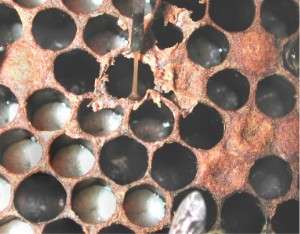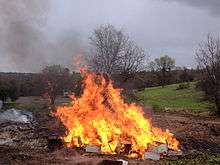American foulbrood
American foulbrood (AFB, Histolysis infectiosa perniciosa larvae apium, Pestis americana larvae apium), caused by the spore-forming bacteria Paenibacillus larvae ssp. larvae (formerly classified as Bacillus larvae[1]), is a highly infectious bee disease. It is the most widespread and destructive of the bee brood diseases.

Characteristics
Paenibacillus larvae is a rod-shaped bacterium, which is visible only under a high power microscope. Larvae up to 3 days old become infected by ingesting spores that are present in their food. Young larvae less than 24 hours old are most susceptible to infection. Spores germinate in the gut of the larva and the vegetative form of the bacteria begins to grow, taking its nourishment from the larva. Spores will not germinate in larvae over 3 days old. Infected larvae normally die after their cell is sealed. The vegetative form of the bacterium will die but not before it produces many millions of spores. Each dead larva may contain as many as 100 million spores. This disease only affects the bee larvae but is highly infectious and deadly to bee brood. Infected larvae darken and die.[2][3]
History
Until 1906 American foulbrood was not differentiated from European foulbrood, and the condition was simply referred to as foulbrood. Thereafter, the terms European and American were used to distinguish the diseases.[4] However the designations do not refer to the geographical distributions but to the areas where they were first investigated scientifically.[5] In 1907, it was demonstrated conclusively that the bacterium Bacillus larvae was the cause of American foulbrood disease by fulfilling Koch's postulates.[6] The geographical origin of AFB is unknown, but it is found almost worldwide.[7][8]
Diagnosis
Lab testing is necessary for definitive diagnosis, but a good field test is to touch a dead larva with a toothpick or twig. It will be sticky and "ropey" (drawn out). Foulbrood also has a characteristic odor, and experienced beekeepers with a good sense of smell can often detect the disease upon opening a hive.[9] However, this odour may not be noticeable until the disease is in an advanced stage. Since response and treatment is required as early as possible to protect other colonies, absence of odour cannot be relied on as indicating absence of foulbrood. Only regular and thorough inspection of the brood can identify the disease in its early stages.
The most reliable disease diagnosis is done by sending in some possibly affected brood comb to a laboratory specialized in identifying honey bee diseases.[10]
Disease spread
When cleaning infected cells, bees distribute spores throughout the colony. Disease spreads rapidly throughout the hive as the bees, trying to remove the spore-laden dead larvae, contaminate brood food. Nectar stored in contaminated cells will contain spores and soon the brood chamber becomes filled with contaminated honey. As this honey is moved up into the supers, the entire hive becomes contaminated with spores. When the colony becomes weak from AFB infection, robber bees may enter and take contaminated honey back to their hives, thereby spreading the disease to other colonies and apiaries[11]. Beekeepers also may spread disease by moving equipment (frames or supers) from contaminated hives to healthy ones.
American foulbrood spores are extremely resistant to desiccation and can remain viable for more than 40 years in honey and beekeeping equipment. Therefore, honey from an unknown source should never be used as bee feed, and used beekeeping equipment should be assumed to be contaminated unless known to be otherwise.[12]

Treatment
European Union law requires all infected hives and equipment to be destroyed.[13] In the US, many State Apiary Inspectors require an AFB diseased hive to be burned completely. The spores can survive up to 40 years and are difficult to destroy.
A less radical method of containing the spread of disease is burning only the frames and comb and thoroughly flame scorching the interior of the hive body, bottom board and covers. Dipping the hive parts in hot paraffin wax or a 3% sodium hypochlorite solution (bleach) also renders the AFB spores innocuous.[14] It is also possible to sterilize an infected hive without damaging either the structure of the hive or the stores of honey and pollen it contains by sufficiently lengthy exposure to an atmosphere of ethylene oxide gas, as in a closed chamber, as hospitals do to sterilize equipment that cannot withstand steam sterilization.[15]
Antibiotics, in non-resistant strains of the pathogen, can prevent the vegetative state of the bacterium forming. Drug treatment to prevent the American foulbrood spores from successfully germinating and proliferating is possible using oxytetracycline hydrochloride (Terramycin).[16] Another drug treatment, tylosin tartrate, was approved by the US Food and Drug Administration (FDA) in 2005.[17]
Chemical treatment is sometimes used prophylactically, but this is a source of considerable controversy because certain strains of the bacterium seem to be rapidly developing resistance.[18] In addition, hives that are contaminated with millions of American foulbrood spores have to be prophylactically treated indefinitely. Once the treatment is suspended, the American foulbrood spores germinate successfully again leading to a disease outbreak.
Thomas Brady at Brigham Young University and Heather Hendrickson at Massey University are currently studying phage therapy to treat American foulbrood.[19][20]
Lactic acid-producing bacteria inhibit the growth of the spore and vegetative cells of Paenibacillus larvae under laboratory conditions. However, the bacteria made no difference to infected honey bee colonies.[21]
References
- Marian JELINSKI, http://www.apidologie.org/articles/apido/abs/1985/01/Apidologie_0044-8435_1985_16_1_ART0007/Apidologie_0044-8435_1985_16_1_ART0007.html Archived 2015-09-23 at the Wayback Machine
- Foul brood disease of honey bees:recognition and control Archived March 18, 2009, at the Wayback Machine Central Science Laboratory National Bee Unit, Department for Environment, Food and Rural Affairs (DEFRA); United Kingdom (excellent publication with many pictures)
- "Bees Disease: One Step Closer To A Cure." Archived 2019-10-09 at the Wayback Machine ScienceDaily 4 May 2008
- Phillips (1906)
- Shimanuki, Hachiro; Knox, David A. Diagnosis of Honey Bee Diseases Archived 2006-12-09 at the Wayback Machine USDA
- White 1907
- Matheson, 1993,1996
- American Foulbrood disease Archived 2011-07-18 at the Wayback Machine A.M. Alippi Laboratorio de Fitopatologia, Facultad de Ciencias Agrarias y Forestales Universidad Nacional deL a Plata, Calle 60 y 118, C.C. 31, 1900 La Plata, Argentina
- "American Foulbrood (AFB)". Bear Country Bees. Archived from the original on 2016-08-09.
- USDA Agricultural Research Service Submission of Samples for Diagnosis Archived 2011-02-04 at the Wayback Machine (2007)
- von Büren, R.S.; et al. (2019). "High-resolution maps of Swiss apiaries and their applicability to study spatial distribution of brood diseases". PeerJ. 7: e6393. doi:10.7717/peerj.6393. PMC 6360077. PMID 30723636.
- American Foul Brood-Prevention and Control Archived 2008-06-26 at the Wayback Machine Pennsylvania Department of Agriculture
- Bee disease confirmed in Perthshire. Scottish Government. Published: 28 May 2020. https://www.gov.scot/news/bee-disease-confirmed-in-perthshire-1/
- Dobbelaere W, de Graaf DC, Reybroeck W, Desmedt E, Peeters JE, Jacobs FJ Disinfection of wooden structures contaminated with Paenibacillus larvae subsp. larvae spores Journal of Applied Microbology (Aug 2, 2001)
- Robinson (1972). "Gas Sterilization of Beekeeping Equipment Contaminated by the American Foulbrood Organism, Bacillus larvae". The Florida Entomologist. 55 (1): 43–51. doi:10.2307/3493642. JSTOR 3493642.
- Calderone, Nicholas Management of Honey Bee Brood Diseases Archived July 27, 2011, at the Wayback Machine (January 2001) Cornell University
- USDA Agricultural Research Service New Antibiotic Approved for Treating Bacterial Honey Bee Disease Archived 2010-10-08 at the Wayback Machine
- Powell, Gordon Cleaning up American Foulbrood Archived 2006-03-15 at the Wayback Machine Iowa Honey Producers Association, The Buzz Newsletter (Jan 2006)
- Brady, T. Scott; Merrill, Bryan D.; Hilton, Jared A.; Payne, Ashley M.; Stephenson, Michael B.; Hope, Sandra (2017). "Bacteriophages as an alternative to conventional antibiotic use for the prevention or treatment of Paenibacillus larvae in honeybee hives". Journal of Invertebrate Pathology. 150: 94–100. doi:10.1016/j.jip.2017.09.010. ISSN 1096-0805. PMID 28917651.
- Morton, Jamie (2018-01-14). "Virus vs disease: New bid to help our honeybees". NZ Herald. ISSN 1170-0777. Archived from the original on 2018-02-19. Retrieved 2020-03-12.
- Sepideh, Lamei (2018-05-03). "The effect of honeybee-specific lactic acid bacteria on american foulbrood disease of honeybees". pub.epsilon.slu.se. Archived from the original on 2018-06-12. Retrieved 2018-06-12.
| Wikimedia Commons has media related to American foulbrood. |
External links
- Learn to identify American foulbrood in 90 seconds YouTube video showing the 'Ropiness test' and scales.